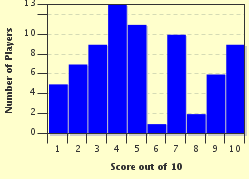Quiz Answer Key and Fun Facts
1. The verb "caber," meaning "to fit," is possibly the most difficult irregular verb to memorize in the present tense, specifically in the "yo" form. What is the proper way to conjugate "caber" in the "yo" form?
2. There are only three verbs in Spanish that are irregular in the imperfect tense; that is to say they don't end in -aba if they are an -ar verb or -ía for -er verbs. Which of these is not irregular in the imperfect tense?
3. The verb "traer" is Spanish for "to bring." In the preterite tense, it can be a little bit tricky to understand right away. Which of these is the correct way to conjugate "traer" in the 3rd person, plural form (ustedes, ellos, ellas)?
4. The future and conditional tenses are conjugated in the same way, except for the ending. With that in mind, what is the common stem for the verb "tener," meaning "to have," for both the conditional and future tenses?
5. Past participles usually end with -ado or -ido, depending on whether the infinitive ends with -ar, -er, or -ir. However, to every rule there are exceptions. Which of these participles is NOT conjugated correctly?
6. The stem-changing verbs can be tricky to master, because there are multiple possible ways a stem can change. Which of the following is the correct "yo" form of the verb "mentir," meaning "to lie," in the present tense?
7. The present progressive ending for -er and -ir verbs is typically -iendo; for example "comer" becomes "comiendo." However, verbs that end with -ñer and -ñir are conjugated differently. What is the present progressive form of the word "gruñir," meaning "to grumble?"
8. The imperfect subjunctive tense is used to describe uncertainty that happened in the past, for example "Yo esperaba que" means "I hoped that." An easy way to remember the way to start conjugating the imperfect subjunctive is to start by taking the 3rd person plural, preterite form of a verb, and then working from there. So, which of these options is not conjugated correctly for the imperfect subjunctive in the "ustedes" form?
9. There are various -go verbs in the Spanish language. The -go verbs are verbs whose "yo" conjugations in the present tense end with -go, rather than just -o. Which of the following verbs is NOT a -go verb?
10. "Hacer," meaning "to do" or "to make," is probably the most difficult all-around verb to master, as most tenses are irregular in some way. Which of these options does not correspond with the correct tense for the tú form?
Source: Author
beadynlsu
This quiz was reviewed by FunTrivia editor
trident before going online.
Any errors found in FunTrivia content are routinely corrected through our feedback system.

